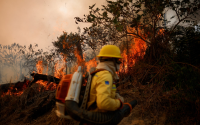9 March 2004Znet / Ha'aretz Daily
This is an admission of failure. The written word is a failure at making tangible to Israeli readers the true horror of the occupation in the Gaza Strip. When something is written about the sea being closed off to Palestinians in the north and south of the Strip, the response will be "they are terrorists." If something is written about neighborhoods in the western part of the Khan Yunis refugee camp and how the buildings are all full of bullet holes from heavy machine guns and cannon shells, the response will be "the Palestinians started it." Tell the story of how 15-year-old Yusuf Bashir's family home in Dir al-Balah has been turned into an army fortress, and in Israel they'll say, "there is no choice, the Jewish settlement of Kfar Darom must be protected, like Kfar Dekalim, Atzmona and Morag."
A report that the soldiers in a military position right next to Yusuf's house agreed to allow a UN team into the family's courtyard will be used in Israel as proof of the humanitarian attitudes of soldiers who are ready to take risks while doing their duties. And when it's reported that suddenly one of the soldiers - an officer, as the IDF spokeswoman would later say - "shot at the wheels of a suspicious vehicle" (the UN team's car), in Israel that will be a shooting that never happened. And then, it will be reported that the boy, Yusuf Bashir, was shot in the back as he waved goodbye to the visitors from the UN, and it is possible he'll remain paralyzed for life - maybe that word "paralyzed" will give a few readers pause. But so many stories about so many Yusufs never get reported, and never will get reported.
This admission of the failure of the written word is not meant to enhance the role of photography. A picture may indeed be worth a thousand words, but for the Israeli occupation to approach some level of comprehension, Israelis need to see tens of thousands of photographs, one after the other, or watch documentaries that are at least eight hours long each, so they could grasp in real time the fear in the eyes of the school children when some whistling above turns into twisted crushed metal with charcoaled bodies inside.
Another movie should show the viewers the vineyards of Sheikh Ajalin, the ripe grapefruits, the peasants who for years nurtured the fruit with great love only to see it all turned to scorched earth left behind by Israeli tanks and bulldozers. No movie has yet been produced that would enable Israelis to taste the wonderful grapes of Sheikh Ajalin. The vineyards are gone so the military positions can protect Netzarim.
How would photographs illustrate the following facts - from September 29th up to Monday this week, 94 Israelis have been killed - 27 civilians and 67 soldiers, according to the IDF. From that same date up to February 18th this year 1,231 Palestinians have been killed - all of them were terrorists? Lacking a central Palestinian agency, there are differences between the data provided by Palestinian groups and none claim to be 100 percent accurate.
The human rights group Mezan, based in Jabalya refugee camp, found that 81 women were killed by IDF gunfire in the Strip; 344 children under the age of 18 were killed by IDF gunfire; 255 members of the Palestinian security and police forces, killed either at their positions or offices and frequently in battle; 264 were armed men who took part in battles with the IDF or tried to attack military positions or settlers and settlements. In the IDF's targeted assassinations, 46 of those killed were the targets of the attacks - and 80 were passersby killed with "pinpoint prevention."
The failure to bring all this home to to readers is not because of the weakness of words or a lack pictures. It is because Israeli society has learned to live in peace with the following facts. There are 8,000 Jews and 1.4 million Palestinians in the Gaza Strip. The total area of the Strip is 365 square kilometers. The settlements occupy 54 square kilometers. Along with the areas held by the IDF, according to the Oslo accords, 20 percent of the Strip is under Israeli control. That's 20 percent of the territory for half of one percent of the population.
The Israeli army's mission is to protect the security of the Israeli half of one percent, which occupies plenty of land, has freedom of movement, opportunities for development, and fresh water - unlike the saline liquid allocated to the Palestinians. Israeli military positions meant to protect the settlements are located inside and beside the settlements and have a commanding view of all the civilian Palestinian neighborhoods.
The proximity of every expansive settlement to the densely populated, suffocating crowded Palestinian community is what causes the large number of Palestinian casualties in the Gaza Strip, including many civilians. It is what determines the flexible rules of engagement, the type of bombs that break into fragments, the unmanned aircrafts that fire missiles.
The IDF operates within the logic of those arrogant, cynical, and ruthless settlements of a privileged fat few sitting in the midst of the only land reserves that the Palestinians have in the Gaza Strip. Despite talk of "withdrawal," Israeli society has yet to show any signs that it is shaking off the blatantly immoral logic that feeds the very existence of the settlements. And that's as true of the Gaza Strip as it is of the West Bank.






